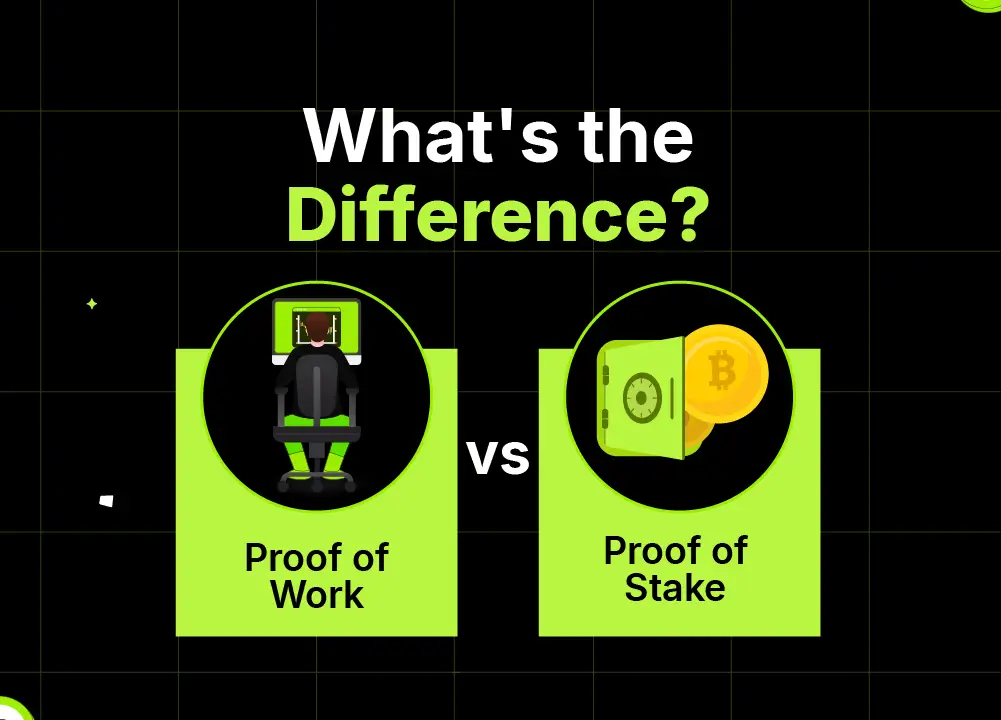
The crypto mechanisms that secure and validate transactions are crucial for the stability and trustworthiness of any digital currency. Two of the most popular consensus mechanisms employed today are Proof of Work (PoW) and Proof of Stake (PoS). Let’s speak about Proof of Work vs Proof of Stake.
While both serve the fundamental purpose of validating transactions and adding new blocks to the blockchain, they operate under quite different principles. Understanding the distinctions between these two systems is essential for anyone involved in the crypto space, whether you’re a miner, investor, or just a curious observer.

Proof of Work (PoW): The Original Consensus Mechanism
Proof of Work (PoW) is a fundamental concept in the realm of cryptocurrencies, notably serving as the backbone of Bitcoin, the first cryptocurrency ever created. Since Bitcoin’s inception, PoW has been integral to the operation and security of numerous other cryptocurrencies. This consensus mechanism is essential for understanding how digital currencies maintain integrity and trust among users, without the need for a central authority.
What is Proof of Work?
Proof of Work is a system designed to ensure that network participants, often called miners, perform a significant amount of computational efforts to validate transactions and add new blocks to the blockchain. In simpler terms, PoW is like a competitive race where miners use their computers to solve complex mathematical problems; the first one to solve the problem gets to add a new block of transactions to the blockchain and, as a reward, receives a certain amount of the cryptocurrency, such as Bitcoin.
How Does Proof of Work Function?
At the heart of PoW is a cryptographic puzzle often related to the hash of a block. A hash is a fixed-size alphanumeric string that uniquely represents data, and hashing involves converting an input of any length into a secured, fixed-length output. In Bitcoin’s case, the SHA-256 algorithm is used.
To complete a block and add it to the blockchain, miners must find a hash that meets certain criteria set by the network, typically requiring the hash to be below a specific target. This target adjusts over time to ensure that the rate at which new blocks are created remains constant, despite fluctuations in the number of miners or their computational power.
The Mining Process
The process of mining involves generating as many guesses as possible in the hope of finding the right hash value. These guesses are made by modifying a small part of the block’s data, known as the nonce. The nonce is combined with the data in the block and passed through the hash function to produce a hash value. If the value meets the network’s conditions, the miner wins the right to add the block to the blockchain. If not, the nonce is adjusted, and the process repeats.
This method requires a substantial amount of computational power, as millions of nonce values might need to be tested before finding the correct hash. The immense energy consumption of PoW mining operations has been a subject of environmental concerns, as it often requires electricity-heavy computer systems running 24/7.
Advantages of Proof of Work
The primary advantage of PoW is security. The difficulty of the mathematical problems ensures that it is not feasible to tamper with the blockchain. To alter any single block, an attacker would need to redo the work for that block and all subsequent blocks, which is computationally expensive and practically impossible as it would require majority control over the network’s mining power.

Proof of Stake (PoS): An Energy-Efficient Alternative
Proof of Stake (PoS) is a consensus mechanism used by blockchain networks to achieve distributed consensus. It was first implemented by Peercoin in 2012 as a more energy-efficient alternative to the Proof of Work (PoW) system used by Bitcoin. PoS has gained popularity over the years, especially with major cryptocurrencies like Ethereum planning to switch to a PoS system in its Ethereum 2.0 upgrade. This move is driven by the desire to reduce the massive energy consumption associated with PoW.
How Does Proof of Stake Work?
Proof of Stake fundamentally changes the way transactions are verified and blocks are added to the blockchain. Unlike PoW, which requires miners to solve complex mathematical problems using powerful computers, PoS chooses validators based on the number of coins they hold and are willing to “stake” as collateral.
In a PoS system, the more coins you hold, the more likely you are to be chosen as a validator for new blocks. This is because having a higher stake in the network presumably aligns the validators’ interests with the network’s well-being. Validators put up a portion of their coins as a stake, and in exchange, they get a chance to validate transactions, create new blocks, and earn rewards. If they validate dishonestly or incompetently, they risk losing some or all of their staked coins, a process known as “slashing.”
Validator Selection
The specific method of selecting validators can vary from one cryptocurrency to another. Some systems choose validators randomly, but the probability of being chosen might depend on the size of the stake. Other systems use a rotating scheme where every staker gets a turn in a predictable sequence, or a combination of these methods.
Energy Efficiency
The most significant advantage of PoS is its low energy consumption compared to PoW. Since PoS does not require complex calculations, the energy required to run a PoS blockchain is minimal, mostly needed for maintaining a network of computers rather than performing continuous, intensive calculations. This reduction in energy use not only helps in making blockchains environmentally friendly but also reduces the cost for participants, making blockchain technology more accessible and sustainable.
Security Aspects
Security in a PoS system is maintained through financial incentives and penalties. Validators have a financial stake in the network’s smooth operation. Any attempt to manipulate the blockchain or validate fraudulent transactions can result in losing their stake. This setup encourages validators to remain honest.
However, some critics argue that PoS might be less secure than PoW because it potentially centralizes control in the hands of those with the most coins. Moreover, various forms of PoS, like Delegated Proof of Stake (DPoS) or Liquid Proof of Stake (LPoS), attempt to address these concerns by introducing additional layers of participant involvement and decision-making processes to distribute control more broadly among stakers.

The Future of Proof of Stake
As concerns about sustainability and environmental impact become more pressing, the appeal of PoS is likely to grow. The adoption of PoS by Ethereum, one of the largest blockchain projects, marks a significant test of its scalability and security capabilities. If successful, it could encourage more widespread use of PoS, potentially setting a standard for future blockchain technologies.
Choosing Between PoW and PoS
Both PoW and PoS offer unique advantages and come with distinct challenges. The choice between the two depends largely on the specific needs and goals of a cryptocurrency network. PoW is praised for its proven security and robustness, making it difficult to compromise. On the other hand, PoS is celebrated for its efficiency and lower environmental impact, making it an attractive option for newer blockchain technologies looking to reduce their carbon footprint.
As the discussion about sustainability in crypto continues, we may see more networks adopting or transitioning to PoS or other more energy-efficient consensus mechanisms. However, for those requiring utmost security and proven track records, PoW remains a formidable choice. Understanding these mechanisms deeply will allow participants in the crypto space to make informed decisions about which currencies to support or invest in, based on their underlying technologies.
Frequently Asked Questions
1. What is the main difference between (PoW) and (PoS)?
The main difference lies in how they validate transactions and add new blocks to the blockchain. Proof of Work requires miners to solve complex mathematical problems using computational power, consuming a lot of energy. Proof of Stake selects validators based on the number of coins they hold and are willing to stake, making it more energy-efficient.
2. How does Proof of Work enhance blockchain security?
Proof of Work secures the blockchain by making it computationally expensive and time-consuming to add new blocks. This effort discourages fraud because altering any block after it has been added would require re-mining that block and all subsequent blocks, which is practically infeasible due to the high cost and effort involved.
3. Why is Proof of Stake considered more energy-efficient?
Proof of Stake does not require the extensive use of computational power to solve complex problems like Proof of Work does. Instead, it relies on validators who stake their own coins to secure the network, which involves much less energy consumption and is therefore more environmentally friendly.
4. What risks are associated with Proof of Stake?
One of the criticisms of Proof of Stake is the potential for centralization, as individuals with larger holdings have greater influence over the network. This could potentially lead to a smaller group of people having control over the entire blockchain. Additionally, there’s a risk of nothing-at-stake attacks, where validators might try to manipulate transaction histories without proper penalties.
5. Can you switch from Proof of Work to Proof of Stake?
Yes, a blockchain network can switch from Proof of Work to Proof of Stake. Ethereum, for example, is transitioning from PoW to PoS in its Ethereum 2.0 upgrade. This process involves complex changes to the network’s protocol and extensive testing to ensure stability and security.
6. How do validators participate in a Proof of Stake system?
Validators in a PoS system must lock up a certain amount of their cryptocurrency as stake. They are then selected to validate blocks based on factors like the size of their stake and the length of time they have held it. Validators earn transaction fees and may receive additional rewards in the form of new coins, similar to miners in PoW systems.
7. Which consensus mechanism is better for new cryptocurrencies?
The choice between PoW and PoS depends on the specific needs and goals of the cryptocurrency. PoS might be preferable for new cryptocurrencies that prioritize energy efficiency and faster transaction times. However, PoW might be chosen for its robust security features. Each system has its advantages and trade-offs, and the decision will vary based on the use case and the values of the cryptocurrency community involved.












